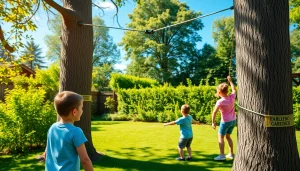Understanding Vertikale Gärten: A Green Solution for Limited Spaces
As urban environments become more densely populated, the necessity for innovative solutions to maintain green spaces is more pressing than ever. Vertikale Gärten, or vertical gardens, emerge as an ingenious way to integrate nature into limited spaces, transforming ordinary walls into lush, living canvases. These gardens not only serve aesthetic purposes but also contribute to environmental sustainability, making them popular among city dwellers eager to bring a slice of nature into their homes.
What are Vertikale Gärten?
Vertikale Gärten are gardening systems consisting of plants cultivated vertically, as opposed to the traditional horizontal layout. Utilizing wall-mounted structures, trellises, or panels, these gardens allow a diverse range of plants to thrive in small areas. They capitalize on vertical space by integrating plants such as flowers, herbs, and vegetables into walls, fences, or other surfaces that would otherwise remain bare.
Patrick Blanc, a pioneer in the field, defines vertical gardens in his book, The Vertical Garden: Nature in the City. According to him, a vertical garden utilizes various techniques to enable plants to grow on a vertically secured substrate, which can be soil-less, soil-based, or hydroponically supported. The result is a visually stunning display of flora that can flourish in otherwise unutilized urban spaces.
Benefits of Vertical Gardening
Vertical gardening offers a host of benefits, particularly in urban settings where space is at a premium. Here are some key advantages:
- Space Efficiency: By utilizing vertical spaces, these gardens allow for the growth of a large number of plants without requiring expansive ground space.
- Improved Air Quality: Plants naturally filter pollutants from the air and release oxygen, contributing to cleaner urban environments.
- Enhanced Aesthetics: Vertical gardens provide a striking visual impact, softening buildings and urban structures while creating peaceful retreats in the midst of concrete.
- Increased Biodiversity: Integrating various plants fosters a habitat for local wildlife, such as birds and beneficial insects.
- Temperature Regulation: Vertical gardens help insulate buildings, reducing energy costs associated with heating and cooling by maintaining lower temperatures in warmer months.
- Crops and Edibles: Many vertical gardens are designed to carry edible plants, allowing urban gardeners to grow their herbs, fruits, and vegetables.
Common Misconceptions about Vertical Gardens
Despite their growing popularity, several misconceptions persist regarding vertical gardens:
- They Require Too Much Space: Contrary to popular belief, vertical gardens are designed for small areas. Many compact designs can fit within balconies or small yards, maximizing existing space.
- High Maintenance Needs: While they do require care, vertical gardens can be efficient with the right irrigation systems and plant selections, minimizing the effort needed to maintain them.
- Only Suitable for Certain Plants: Many believe vertical gardens can only utilize specific types of plants. However, a wide variety of options exist—from succulents to climbing vegetables, capable of flourishing in vertical arrangements.
Designing Your Own Vertikale Gärten: Essential Tips
Choosing the Right Location
The first step in creating a successful vertical garden is selecting the right location. Consider the following:
- Sunlight Exposure: Assess how much sunlight the location receives daily. Most vegetables and flowers thrive with at least 6 hours of sunlight, while some shade-loving plants prefer indirect light.
- Wall Texture and Material: The surface used for vertical planting should be suitable for the plants chosen. Wood, metal, and concrete can all work, depending on the system used (e.g., planters or hydroponics).
- Accessibility: The garden should be easily reachable for regular maintenance tasks, such as watering, pruning, and harvesting.
Selection of Plants for Vertical Gardens
Choosing the right plants is crucial to the success of your vertical garden. Some popular choices include:
- Herbs: Basil, mint, thyme, and parsley are great for culinary use and thrive in small spaces.
- Flowers: Petunias, ferns, and orchids add color and vibrancy, attracting pollinators and beautifying the space.
- Vegetables: Leafy greens like lettuce and climbing plants such as tomatoes or cucumbers can yield bountiful harvests in vertical setups.
- Succulents: Ideal for drier areas, succulents like sedum or echeveria require less water and are low-maintenance options.
Materials Needed for Installation
Successfully installing a vertical garden involves gathering the right materials. Here’s a basic checklist:
- Framework: This may include wooden pallets, trellises, or commercially available vertical garden systems.
- Containers: Ensure you have adequate planters, pots, or mesh pockets designed to hold soil and plants.
- Soil and Fertilizer: Use a lightweight, well-draining potting mix tailored to your plant’s needs, along with slow-release fertilizers.
- Watering System: Consider installing a drip irrigation system for consistent moisture levels or use self-watering containers for convenience.
Maintenance Practices for Thriving Vertikale Gärten
Watering and Nutrient Considerations
Proper watering is crucial since vertical gardens can dry out faster than traditional gardens due to their exposure and design. Follow these guidelines:
- Water regularly based on the plants’ needs; some may require daily watering while others thrive with less frequency.
- Select suitable fertilizers that cater to your plants and ensure they are evenly distributed for optimum growth.
- Use biodegradable nutrient-rich solutions to enrich the soil naturally and promote healthy plant growth.
Pest Control in Vertical Spaces
To maintain a healthy vertical garden, it’s essential to manage pests effectively:
- Implement organic solutions such as neem oil or insecticidal soap to combat pests without harming beneficial insects.
- Regularly inspect plants for signs of infestation, such as discoloration, webbing, or unusual markings.
- Encourage ladybugs and other beneficial insects by incorporating companion plants that attract them naturally.
Seasonal Care for Your Vertical Garden
As seasons change, so do the requirements of your vertical garden. Ensure you adapt your practices accordingly:
- In summer, provide more frequent watering and shade for sensitive plants during extreme heat.
- During winter, insulate your plants against cold temperatures using protective covers or by bringing non-hardy plants indoors.
- Springtime is ideal for pruning and replanting; refresh your garden by removing dead plants and introducing new varieties.
Innovative Approaches to Vertikale Gärten: Techniques and Styles
Using Hydroponics in Vertical Gardening
Hydroponic systems allow plants to grow without soil, relying instead on nutrient-rich water solutions. This method saves space and reduces the risk of soil-borne pests and diseases.
Considerations for hydroponics:
- Invest in a quality hydroponic system that suits your available space, whether indoors or outdoors.
- Monitor pH and nutrient levels regularly to ensure optimal growth.
- Integrate support structures within the system to accommodate climbing plants.
Integrating Technology: Smart Systems for Vertical Gardens
As technology advances, so do the tools available for vertical gardening. Smart systems can automate watering, monitor plant health, and adapt environments:
- Consider timers and sensors that can be programmed to water based on soil moisture levels.
- Use mobile apps that provide real-time data and alerts regarding plant health and growth conditions.
- Integrate LED grow lights to support plants in low-sunlight areas, ensuring they receive adequate light for growth.
Artistic Expressions: Vertical Garden Design Trends
Vertical gardens are not just functional; they can also be artistic expressions. Emerging trends include:
- Asymmetrical designs that incorporate varying plant heights for visual interest.
- Interactive designs that invite touch and engagement, encouraging visitors to experience the garden physically.
- Integration with art, such as sculptures or murals that complement the greenery, creating a unique urban landscape.
Case Studies: Inspiring Vertikale Gärten Around the World
Urban Vertical Gardens: Success Stories
Many cities worldwide have embraced vertical gardening to enhance their urban jungles. For instance:
- The CaixaForum building in Madrid, boasting a vertical garden by Patrick Blanc, attracts visitors globally to admire its artistic integration of foliage and architecture.
- Singapore’s Gardens by the Bay features vertical plant installations that blend horticulture with groundbreaking architecture, promoting biodiversity and green living.
Commercial Spaces Adopting Vertical Greenery
Businesses are recognizing the benefits of vertical gardens, enhancing aesthetics while improving air quality and client experience:
- Many restaurants have begun installing vertical gardens to highlight fresh herb usage, creating a farm-to-table ambiance.
- Office buildings with green walls have reported higher employee satisfaction and productivity due to improved air quality and aesthetics.
Community Projects Fostering Green Walls
Community-based initiatives have sprung up to encourage the creation of vertical gardens:
- Local schools have introduced vertical gardens as part of environmental education programs, teaching students about sustainability and ecology.
- Neighborhood groups are collaborating to develop vertical gardens in public spaces, promoting community engagement and beautification efforts.






